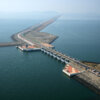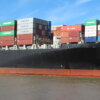Dredging is the excavation of material from the bottom of waterways to deepen or clean them or from the ocean to use for beach restoration or reclamation.
This includes both the excavation and removal of a variety of materials – sediment, sand, rock and debris – from waterways, such as harbours, ports, lakes and rivers, usually for the purpose of deepening or cleaning them. Sand excavated from the ocean is used for beach restoration and land reclamation.
Maritime Infrastructure
Dredging is used to address a broad range of maritime infrastructure needs – with economic, social and environmental implications.
Dredging deepens ports and access channels to accommodate global waterborne freight transport of goods.
Dredging also excavates or ‘mines’ sand from far offshore and then transports these materials to onshore locations where they are used to replenish eroded beaches and rebuild coastlines for protection of low-lying areas.
Modern dredging vessels and technologies can collect and transport large quantities of sand to improve and expand existing ports, and to build land reclamations, which form platforms for offshore airports, residential and commercial areas.
Planning, design, construction
Dredging requires thorough planning, design and construction, which involve engineers, scientists and highly trained crews representing a wide range of skills.
Most projects require extensive pre-dredging preparation including a variety of bathymetric, geological and geophysical analyses. These help the client and contractor to understand the nature of the materials to be dredged. To define the quantity or area to be dredged, acoustic sounding techniques are often used.
Environmental impact assessments are also a crucial part of project planning for dredging.
Underwater technologies
Dredging excavation occurs underwater, often in deep water, where the process cannot be seen. Since visibility is limited, sophisticated technologies have been developed to visualise and guide the work.
Transporting and placing dredged material
Excavation is, however, only the first phase of the dredging process. The next steps are transport of these materials and finally the placement or disposal of the materials depending on the type of material and whether it is clean or contaminated.
The transportation and placement phases require equal consideration and emphasis in the planning stages. A cost/benefit analysis is advised: evaluating the benefits to be gained or the impacts associated with the excavation process and materials excavated.
related
Articles
Publications
Dragado para el Desarrollo (Dredging for Development)

A clear non-technical introduction to the complex field of dredging, published in co-operation with the International Association of Ports & Harbors.
Dredging for Development

A clear non-technical introduction to the complex field of dredging, published in co-operation with the International Association of Ports & Harbors.
Seminars & Courses
Videos
‘The larger forces behind the drivers of change’ presentation by Julius Senn (London School of Economics Enterprise)

Julius Sen is Associate Director and Senior Programme Adviser at the London School of Economics Enterprise. His areas of responsibility include project design and delivery of executive education and consultancy programmes relating to economic and trade policy issues especially as they relate to globalisat















